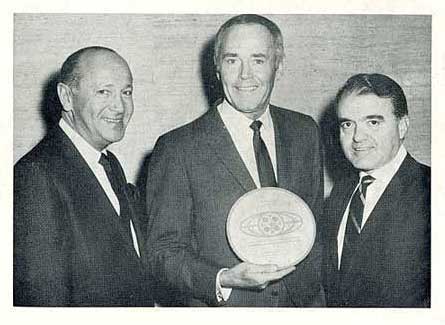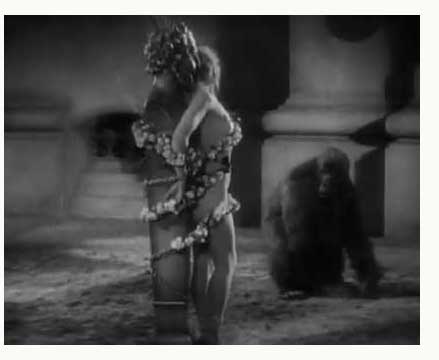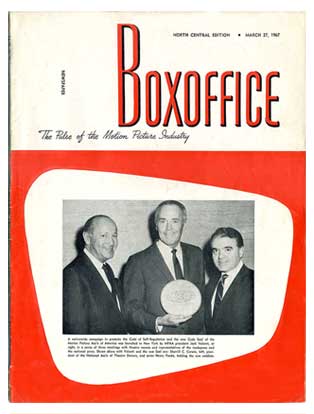Boxoffice Magazine, North Central Edition, March 27, 1967:
Steps in the Right Direction –by Ben Shlyen, Editor in Chief and Publisher, The National Film Weekly
Editors notes: By the 1920s films companies were pushing the limit of that which was acceptable in film. Risqué films and a series of off-screen scandals involving Hollywood stars became the norm. Corrupt turned into morally questionable. “The New York Stage frequent source of subsequent screen material, had topless shows, performances filled with curse words mature subject matters, and sexually suggestive dialogue.” Strange. We ended right back there. Right from the start studios had blocks of people doing “spin control” Roger Rabbit “I’m not bad. I’m just drawn that way”. Supreme Court, 1915, unanimous decision Mutual Film Corporation vs. Industrial Commission of Ohio free speech does not extend to motion pictures. 1921, 37 state legislatures introduced censorship bills. 1930, The Motion Picture Code regulated pictures defining moral code. 1968, The Motion Picture Association (MPAA) dropped the old MPPC code setting up the current MPAA film rating.

A nationwide campaign to promote the Code of Self-Regulation and the new Code Seal of the Motion Picture Association of America was launched in New York by MPAA president Jack Valenti, at right, in a series of three meetings with theatre owners and representatives of the trade press and the national press. Shown with Valenti and the new seal are: Sherrill C. Corwin, left, president of the National Association of Theatre Owners, and actor Henry Fonda, holding the new emblem”
The launching by Jack Valenti, president of the Motion Picture Association of America, of a national campaign to promote the Code of Self-Regulation and the Code Seal is, as Sherrill Corwin, president of the National Association of Theatre Owners, called it, “A significant step in the right direction and… one of the most gratifying events of recent years for exhibitors,” for which Mr Corwin gave assurances of “overwhelming approval of the program” by the NATO directors at their board meeting to be held in Palm Springs next month. Exemplary, too, is the fact that the heads of leading circuits, who attended the meeting Mr. Valenti, held with the theater men, have pledged their full support for the approximately 2,000 theatres they represent.
Improving the image of the motion picture industry – and its product – in the minds of the public is a many faceted never ending task. There is no one thing that can be done to attain the desired result. In fact, it is necessary to have many things at the same time and to keep going, along with new ideas that may be developed.

The MPAA has long kept up a continuing effort through various approaches to “reaching” the public on behalf of the industry at large; and exhibitors, individually and through their regional and national associations, have carried the ball at the local level. This team work has always been necessary in dealing with the public. However the plans originate, they can only be carried forward at the public’s point of contact with the industry on the theatre level. So it is encouraging to have Mr. Corwin’s assurance of the cooperation of the exhibitors in the campaign projected by Mr. Valenti, “ to make the Code of Self-Regulation and the new Code Seal and it’s use more meaningful to theatre patron’s.”
It is noteworthy that, soon after Mr. Valenti took office as president of the MPAA, he introduced the new Production Code, which he said was “designed to keep closer harmony with the mores, the culture, the moral sense and the expectations of our society.” In restating this, Mr. Valenti said “The Code Seal on a film means that it is within the creative boundaries of reason and good judgment. It is our aim to let the movie going public know that this is the mark of a responsible motion picture industry. “
There may be those among the public who would question this, in the light of some pictures that were made before the new code was implemented and a few that have not been fully adjusted to it. But there has been a noticeable uptrend in compliance, which, it is expected, will continue. As it is now known, but perhaps, not as extensively among the public as it should be, films that may be deemed unsuitable for children are to be designated in advertising as “SUGGESTED FOR MATURE ADULTS.” However, this should be given more prominent display than has been the case in some advertisements.

In reference to the “SMA” phase, Mr. Valenti pointed out that it is a part of the industry’s new production Code and is intended as a special information service for parents, enabling them to decide for themselves whether a specific picture is one which their children should or should not see.
The public needs to be better informed as to the Code Seal and its meaning. Accordingly, the MPAA is making a kit of materials to exhibitors, which we urge them to use and keep using. The kit consists of color trailers featuring Julie Andrews and Jack Lemmon and 50-second informative speeches explaining the new Code Seal regulations; a plaque of the new Seal for display in the theatre, indicating the theatre’s support of the Code; a copy of the Code itself, a new Seal brochure answering a number of important questions about the Code and its meaning and general publicity material that exhibitors can use to inform the press, parents, schools, civic groups and churches.
If there is a feeling by any exhibitor that participation in the Code campaign will prohibit his playing any non-Seal pictures, he can dispel that thought. For, as Mr. Valenti stated, in the meetings held last week, there would be “no coercion of exhibitors requiring them not to play non-Seal films; they must make the decision on what films to play themselves.”
Since industries beginning, it has fought and won many battles for the “freedom of the screen.” But the fight is not yet over; there is still much ground work to be done. The Code campaign, addition to improving the industry’s image, can be of great service in the preservation of the motion picture’s rights to the freedom of expression.
